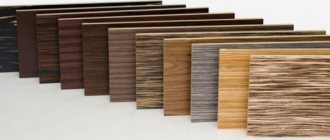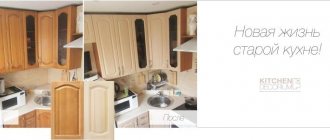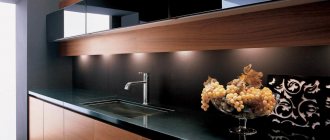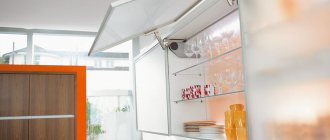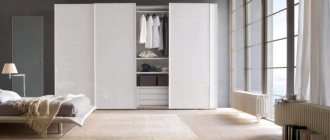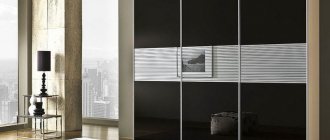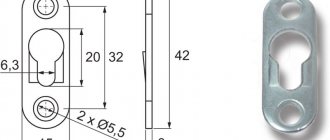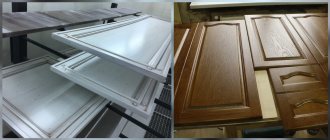Repair
0
82 164
Share
Partial restoration of kitchen facades allows you to update the interior, make it fresher, and visually attractive. Replacing a kitchen unit can be quite expensive, so you can only update the facade. This restoration technology will help change the appearance of the furniture, while its main parts will remain old, which will significantly save on replacing cabinets.
- Benefits of façade renovation
- How to fix the problem?
- Using heating devices
- Restoring coating using friction
- Application of glue
What to do if the PVC film peels off from MDF facades?
Everything is of course individual, you need to see where and how the film came off.
If it’s all over the facade, then most likely it’s a factory defect; such a facade must be returned to the seller; you can glue it at home, but it’s unlikely that you’ll be able to glue the film completely.
Before starting work, you need to know that PVC film is glued to the MDF facade under pressure and temperature; you can start with similar methods.
The easiest way (by the way, he helped me, not surprisingly, he glued the facade of the kitchen) is to take a dry rag in your hands and, with progressive movements “back and forth”, begin to rub the peeled place, as if by doing this, you will create both temperature from friction and pressure, temperature will bring the dried glue under the film into working condition.
Work without fanaticism and stop, too much effort is not needed here.
rub and look at the result.
If this method does not help, proceed to plan B.
We take a hairdryer in our hands, you can use a regular one, but it’s better to use an industrial (construction) one and heat up the place where the film has come off, the glue will “melt” and then, as it were, we “rub” the film into the facade, towards the edges.
The next method is similar, but instead of a hair dryer we use an iron and a cloth, “iron” the surface, activate the glue, then press the film.
If nothing helps, then move on to the last plan “C”.
We buy quick-drying glue, such as “Super-moment”
Something should help, but in general you need to remember that PVC film is afraid of elevated temperatures and if your film has come off on the kitchen facade in the area of the oven or gas stove, then you need to think about how to insulate the facade and the stove, the film will come off forever, if don't do this.
I had a similar case on a kitchen set; the film began to peel off from the door of the adjacent cabinet near the sink. At first, my suspicions were that water was getting in there, but upon careful inspection, no traces of water were found.
There was something similar, only on one door approximately in the middle:
So first of all, understand the reasons!
I removed the door and began to carefully examine it; it turned out that the film had peeled off not even from the very edge, but about 2-3 centimeters from the edge.
The appearance was actually deplorable, so it was decided to open the swollen surface.
I took a utility knife and cut the swelling right in the middle, then cut away from the cut at a right angle.
After opening it, I discovered a defect.
Approximately, as I said, from the edge, 3-4 centimeters between the glued part of the MDF and the film, there were small shavings with some kind of dust or dirt, and it was from this part that the film began to lag behind.
Previously, I was advised to warm it up with an iron, but I’ll tell you straight away that nothing would have worked, the film wouldn’t stick to this dirt.
The next steps were:
- First I cut the film down to where it held well.
- I cleaned all the dirt and dust from the surface and as much as possible from the film
- The entire area was treated with solvent.
- Next we had to glue the film.
On the Internet I found a lot of recommendations on what kind of glue to use, but the problem was to buy this glue, there were no small tubes in our city, so I had to go to the craftsmen who assemble kitchens. I took some of this glue from them:
It was with them that I glued the film back. And I glued it like this:
- Since I cut the place of the swelling with a cross, I had to glue each piece in turn, otherwise I could not press the film to the facade, this action took 2 days, it took 12 hours for gluing.
- Each piece had to be pressed down with a weight.
After gluing, there was a visible cross from the cut, but the film itself stuck well.
________________ _______
I came to the following conclusion:
Most likely, while gluing the film to the facade, something got on the surface; at first, the film may have been stretched and the place was not protruding so much, but over time, when exposed to temperature, the film became limp, and so the swelling appeared.
Using heating devices
If the PVC film peels off from MDF kitchen facades, you can try replacing it with a new film or gluing the old material in place using available electrical appliances. This could be an iron, a powerful home or construction hair dryer. The film needs to be carefully warmed up: it should become quite soft and blurry, but not start to melt. If you have something to try, use these pieces or on an inconspicuous place on the façade. The device is pressed against the edge that is not glued for a few seconds. The film should stretch, the glue should warm up at this moment, and the material should protrude towards the back side of the facade and adhere firmly. If this can be done, then it will be possible to glue the entire facade in this way, in places where the film has retreated.
Advice: the film itself cannot be heated with a hairdryer at close range, as this will curl it and be damaged.
This DIY restoration of kitchen facades requires some skill, but is quite simple to perform and does not require the use of expensive tools or materials. If the inside and corners are poorly glued, you can use a metal rod comparable in size to the frame. First you need to warm it up. For this, you can use, for example, a gas burner.
Restoring coating using friction
Restoring kitchen facades from MDF using this method does not require any available tools at all. In order to glue the separated section of the film, you need to cover it with a rag and start rubbing it with your fingers, pressing the film. If there is adhesive underneath, the temperature from friction in a small area will be enough to activate a chemical reaction and cause the film to stick.
Advice: this method should be used carefully, as there is a high risk of damaging the film, exposing its edge or removing the top layer, which will ruin the appearance of the coating.
Application of glue
Restoring a glossy kitchen can cause some difficulties, since gloss does not tolerate strong physical impact, which is why it should not be roughly rubbed with your fingers or heated closely with any appliances. You can try a safer method - gluing the separated film using “Moment”. Most often, such a film peels off in the kitchen, since it is not affected by hot steam. It is necessary to restore the coating as quickly as possible, otherwise the furniture itself will be damaged. The glue must be applied to the untreated area of the facade and to the film itself along the edge so that it can isolate the seam from negative influences. All this must be done carefully, as the glue easily sticks and gets dirty.
Conclusion: inexpensive do-it-yourself kitchen restoration is quite accessible; it is advisable to look at photos of the finished results in advance. With a careful and competent approach, you can easily restore the appearance of the kitchen without resorting to replacing parts and without spending money and completely replace the facades.
Source
PVC film peels off from MDF facades
Good afternoon. I bought a kitchen with MDF facades. In the area of the built-in gas oven, the PVC film is peeled off from the facades on both the right and left. Yes, it doesn’t just peel off, but curls up (in addition, on other facades that are far from the oven, there are also peelings of the film) during the first cooking. I measured the temperature - the facades heat up to 70-73 degrees. The distance from the facade to the slab itself is less than 1 cm. The company already replaced all the facades for me once for the same reason, but last time there was almost no glue between the facade and the film, but this time the glue was spread well. What to do? They will replace it for me, but again with the same facades. And I am 100% sure that they will come off too. How can you solve the heating problem?
PS. I found out that Korean film is used. They also have German PVC film, but apart from the fact that it is thicker, they cannot say anything.
Here's an Ardo gas oven » > It has ventilation holes on the top of the front side, where the heat comes out. This is the cooling principle" >
PS. If I move the oven forward (toward me) 1-2cm, will this help improve the situation? I’m also wondering if I could take the end strip (which fits over the end of the countertop) and stick it in as a barrier between the oven drawer and the front drawer?
Only it is aluminum, won't it have the opposite effect?
Yes, this happens. Not only you. Even on the top drawers (fronts) above the oven. Replacing facades does not always help. You can take a photo of furniture with facades and an oven.
Here is a view of the oven and fronts
This is how the film peels off (sorry about the quality)
I came across this. There is only one treatment - to provide a gap. Either air (void) or from a plank (chipboard possible) 30-40-50 mm. Right and left. Or change the facades to non-film ones.
Good afternoon, I think replacing the facades will not solve anything, because... Little depends on the film, but what kind of glue is used by the façade manufacturer, that’s the question, and is this glue resistant to elevated temperatures? Maybe you should install other facades with postforming or painted MDF, it seems to me that Tony can withstand such temperatures better
This is a problem with household appliances in this price range. Ardo is the most problematic product. All normal built-in doors have side protection, or the door is made in such a way as to prevent heating of the furniture.
Or frame ones. But it’s expensive to change all the facades. Can I change only two cabinets? By reducing their width to provide a gap?
Rusland wrote: This is how the film peels off
I read somewhere on furniture forums about how the film peels off completely and remains hanging on the handles.

